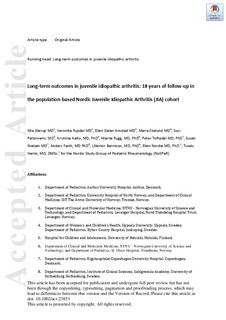| dc.contributor.author | Glerup, Mia | |
| dc.contributor.author | Rypdal, Veronika Gjertsen | |
| dc.contributor.author | Arnstad, Ellen Dalen | |
| dc.contributor.author | Ekelund, Maria | |
| dc.contributor.author | Peltoniemi, Suvi | |
| dc.contributor.author | Aalto, Kristiina | |
| dc.contributor.author | Rygg, Marite | |
| dc.contributor.author | Toftedal, Peter | |
| dc.contributor.author | Nielsen, Susan | |
| dc.contributor.author | Fasth, Anders | |
| dc.contributor.author | Berntson, Lillemor | |
| dc.contributor.author | Nordal, Ellen Berit | |
| dc.contributor.author | Herlin, Troels | |
| dc.date.accessioned | 2020-02-17T16:06:03Z | |
| dc.date.available | 2020-02-17T16:06:03Z | |
| dc.date.created | 2020-01-10T15:15:00Z | |
| dc.date.issued | 2019 | |
| dc.identifier.issn | 2151-464X | |
| dc.identifier.uri | http://hdl.handle.net/11250/2642089 | |
| dc.description.abstract | Objectives
This study assessed the long‐term course, remission rate and disease burden in juvenile idiopathic arthritis (JIA) 18 years after disease onset in a population‐based setting from the early biologic era.
Methods
A total of 510 consecutive cases of JIA with disease onset between 1997 and 2000 from defined geographic regions in Denmark, Norway, Sweden and Finland were prospectively included in this 18‐year cohort study. At the follow‐up visit, patient‐reported, demographic and clinical data were collected.
Results
The study included 434 (85%) of the 510 eligible JIA participants. The mean age ± SD was 24.0 ± 4.4 years. The median juvenile arthritis disease activity (JADAS71) score was 1.5 (IQR 0‐5), with the ERA category of JIA having the highest median score, 4.5 (IQR 1.5–8.5) (P=0.003). In this cohort, 46% still had active disease, and 66 (15%) were treated with synthetic disease‐modifying anti‐rheumatic drugs and 84 (19%) with biologics. Inactive disease indicated by JADAS71 <1 was seen in 48% of participants. Clinical remission off medication (CR) was documented in 33% of the participants with high variability among the JIA categories. CR was most often seen in persistent oligoarticular and systemic arthritis and least often in ERA (P<0.001).
Conclusions
A high prevalence of the JIA cohort did not achieve CR despite new treatment options during the study period. The ERA category showed the worst outcomes and, in general, there is still a high burden of disease in adulthood for JIA. | nb_NO |
| dc.language.iso | eng | nb_NO |
| dc.publisher | Wiley | nb_NO |
| dc.title | Long-term outcomes in juvenile idiopathic arthritis: 18 years of follow-up in the population-based Nordic Juvenile Idiopathic Arthritis (JIA) cohort. | nb_NO |
| dc.type | Journal article | nb_NO |
| dc.type | Peer reviewed | nb_NO |
| dc.description.version | acceptedVersion | nb_NO |
| dc.source.journal | Arthritis care & research | nb_NO |
| dc.identifier.doi | 10.1002/acr.23853 | |
| dc.identifier.cristin | 1770458 | |
| dc.description.localcode | This is the peer reviewed version of an article, which has been published in final form at https://doi.org/10.1002/acr.23853. This article may be used for non-commercial purposes in accordance with Wiley Terms and Conditions for Self-Archiving. | nb_NO |
| cristin.unitcode | 194,65,15,0 | |
| cristin.unitcode | 1920,1,0,0 | |
| cristin.unitname | Institutt for klinisk og molekylær medisin | |
| cristin.unitname | Barne- og ungdomsklinikken | |
| cristin.ispublished | true | |
| cristin.fulltext | postprint | |
| cristin.qualitycode | 2 | |
